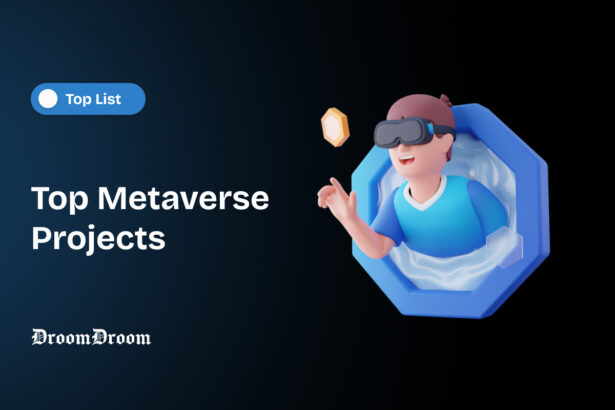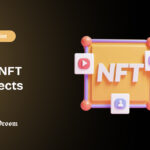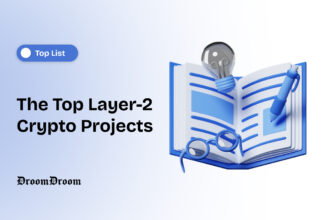Virtual reality is no longer described as science fiction but rather a growing aspect of the tech community. Innovative ideas and technology continue to evolve, bridging the virtual space and real-life experiences. While this may be met with criticism, it is difficult to deny the revolutionary change virtual reality would bring to our daily lives.
Top metaverse projects & companies are leading the revolution and advancement of the metaverse for their users through a more interactive and immersive experience, similar to the real world and everyday human experiences. These metaverse companies invest millions of dollars in research and product development to achieve their goals.
This article covers all the nitty-gritty details you need to know about the metaverse, how it works, the top companies shaping it, and their approaches to achieving it.
What is Metaverse?
Metaverse is a growing concept that involves a collective idea of digital spaces with enhanced interactivity and 3D-infused features, creating near-life experiences for its users. It refers to a virtual environment where users can engage and interact by leveraging the internet and third-party web features, including cryptocurrencies, avatars, and an enhanced user interface.
Metaverse technology hosts an ecosystem where people can interact socially and professionally, narrowing the gap between our daily lives and virtual activities. Using real-time features and blockchain technologies like DeFi, there is increased interoperability between applications that are modeled after real-life structures using 3D, creating numerous independent niches for different activities, including gaming and learning spaces.
How Metaverse Works?
With the fusion of Augmented Reality and Virtual Reality, the metaverse is no longer an illusion. Instead, it is a more impactful and realistic iteration of a universal digital ecosystem focused on both social and economic development and interaction. The metaverse is usually developed by infusing Web3 and blockchain technologies, creating a decentralized internet. By incorporating decentralized finance tools and edge computing, you can learn, build, shop, and play within a designated virtual environment. The idea of mixed realities breeds collaboration, opportunities, entertainment, and immersive experiences, creating excitement and expectations.
The Metaverse Now?
The metaverse cuts across different sectors, including gaming and healthcare. Even in its infancy, this technology makes remote work and collaboration easy and productive. During the pandemic, virtual platforms were maximized to offer help, training, and even research across the globe. From conducting surgical procedures, and investing in virtual real estate to using AI-powered holograms at meetings and online events, the metaverse has the potential to disrupt static social interactions. This reflects one of the reasons why metaverse companies are important.
Top Metaverse Projects & Companies
Axie Infinity
In the world of digital gaming, Axie Infinity offers a play-to-earn gaming experience to its platform users and leverages NFT features. Developed by Sky Mavis and released in 2018, it is a decentralized playground where gamers can buy and train their digital pet avatars called Axies, which they can trade and set to battle other Axies. Players can earn real-life value while playing on the virtual platform by minting and collecting NFTs, virtual lands, and other in-game collectibles, which can be traded in the game’s economy.
The game is one of the metaverse companies built on an Ethereum-linked chain known as the Ronin Network and has its own cryptocurrency, AXS. The players actually pay to play and earn tokens on the game payable after fourteen days. This blockchain-based gaming metaverse has generated impressive revenue, totaling 2.3 million dollars in virtual estate sales by November 2021 and 400 million dollars in sum.
Axie Infinity is an instance of a successful implementation of the metaverse until it experienced a dip in floor price due to a hack attack, costing the platform over 600 million dollars in USD and Ether. Also, the value of the platform’s secondary cryptocurrency plummeted, dropping 90% of its peak value. Though the company cushioned the loss and repaid players affected by the hack, the performance and activity level dropped significantly from 2 million to 250,000 average daily players.
Nvidia
OmniVerse, a real-time platform focused on shared virtual worlds, is one of those metaverse companies that was created by Nvidia, raising its stock value significantly. The Graphics Processing Units (GPUs) designing and producing company is sharing its vision of an immersive network. This vision birthed the Omniverse, a 3D platform tasked with providing a remote collaborative environment for individuals where workflows and scalable applications are shared and deployed, reducing the limitations of location, regulatory tape lines, and other factors. It is built on Universal Scene Description and is compatible with most 3D software, from Adobe to Blender and Cesium.
One striking feature of the Omniverse is its commitment to bringing both worlds – virtual and physical – together in a single space by allowing AI-driven physical simulations. Rather than being merely entertaining, the computing platform embraces real-life solutions and utility. Content creation, design modeling, and real services like industrial engineering are some of the features offered by the Omniverse, taking the world a little deeper into greater problem-solving and capital works. On this shared collaborative platform, anyone and everyone can build metaverse companies (applications) and other life-enabling projects.
The Tale of Digital Twins
In pursuit of its goal of an industrial metaverse, Nvidia developed AI-enhanced virtual simulations that are synced with real-life timing, following the laws of physics, advanced computing, and 3D mechanics to create virtual replications of world assets, environments, and procedures. It allows users to build and run life-changing products in real time. The goal of the digital twins is to optimize complicated processes in industrial and scientific research and product development, as well as testing before deployment, enabling developers, researchers, and designers. Nvidia’s Digital Twins are currently deployed on NVIDIA OVX, a computing system with the performance capability to create metaverse worlds. It remains one of the successful iterations of the metaverse.
Roblox
Roblox is a gaming corporation and one of the early adopters of metaverse features. It allows users to play and develop games as well. While the platform is free to play, in-game assets are traded with Robux, the platform’s virtual currency. As a social platform, Roblox offers impressive 3D features to create an immersive experience for its users, allowing them to build virtual playgrounds and engage with other players worldwide. This includes a customizable interface, microfinance features for trading assets, and a wider audience. With an activity level of millions of active daily users, Roblox’s popularity has increased considerably since 2010.
Some impressive functionalities within the Roblox ecosystem, which make it a commendable metaverse replication, include, like most metaverse platforms, decentralized technologies – blockchain and cryptocurrency, spatial computing, and 3D landscaping features. While Roblox’s primary focus is on gaming environment development, it does not seem to be heavily invested in AR technologies. This could be due to its dependence on its vast network of developers. Its users can develop and customize their avatars to interact, engage, and explore the virtual platform.
As an encouraging step, however, notable global gaming events like the Roblox Metaverse Champions have been hosted and attracted new users even without VR and AR technology. A fertile ground for creativity and positive community interactions, Roblox ensures flexibility in creating social interactions and immersive experiences for both users and the creator community.
As one of the leading tech giants, Google is not left behind and has worked on various AR and VR projects like Google Glass and Google Cardboard before venturing into the metaverse and having a product that can be categorized among metaverse companies. Google’s drive to offer an immersive experience to users has led to exploring the Starline project.
Relying on blockchain and Web3 technologies, virtual worlds are replicating their real-life counterparts. Modeled in 3D and infused with high-tech features, including cameras and sensors, users can have shared virtual experiences. Quite different from other metaverse projects, you will have to enter a Starline Booth to experience virtual spaces. While the project has the potential for groundbreaking success, with important components like virtual objects, VR, 3D content, avatars, AI, and cloud computing, it is not yet at a mature stage and continues to undergo modifications and improvements for an enhanced experience and data security.
Meta
Extending its digital presence beyond a global messaging platform, Meta, formerly known as Facebook, has launched various metaverse projects in a pioneering pursuit of technology with many categorizing it among metaverse companies. The change in brand name from Facebook to Meta communicates the desire to lead the decentralized internet. While Meta’s metaverse is just a part of a much bigger meta world, it has made remarkable strides in its development.
Some of its recent updates include a VR headset known as Meta Quest. The headset units are described as standalone gadgets for navigating the metaverse. You can connect, shop, and learn with the high-tech goggles over your eyes. Its near-to-life simulations, both visual and audio, create an amplified virtual space experience. To increase accessibility and inclusiveness, the Meta corporation dropped the need to own a Facebook account to access the Meta Quest 2 and Pro, selling millions of VR headsets. Beyond the headsets, you can access the meta worlds from your mobile apps, using gaming consoles, and AR gears. Its goals revolve around education, workrooms, and events like comedy shows and concerts.
Investing in Horizon Worlds, the development team launched an advancement of creative tools and innovative technologies to create a quality experience for users, offering up to 10,000 virtual spaces accessible with Meta headsets.
However, layoffs and a notable decline in the corporation’s revenue and user activity, regardless of heavy investments – estimated at 10 billion dollars, signal that the project is not as profitable since the economy has become unpredictable.
Microsoft
The company announced that the metaverse is coming to Teams, a collaborative space for learning and meetings. Microsoft Teams is one of the leading virtual social interactive spaces, and integrating metaverse technologies would certainly maximize the platform’s usability. Collaborating with Meta, Microsoft aims to bring applications like Microsoft Excel and Word into the world of mixed realities, accessible through a tech device tagged HoloLens. It offers improved interactivity through holographic experiences and AI-powered features like avatars. Harnessing 3D technologies, models of real-life assets and people are created and can be used during meetings and other sessions.
Working together, Microsoft and Meta both metaverse companies are optimistic about onboarding Microsoft Mesh for Teams on Quest. This would enhance interoperability across both platforms, allowing users to connect and collaborate using their avatars on the platforms. Accenture, a professional services firm, onboard more than 1000 employees using the Mesh. Its features allow every employee to create their avatars and attend meetings in a futuristic environment with a virtual boardroom.
While most of its development is for more enhanced work and learning virtual environment, Microsoft would integrate Xbox Games into the Meta Quest Store, making it accessible on the Meta headsets.
Decentraland
One of the first virtual worlds with a range of use cases and assets, Decentraland is a decentralized virtual platform that leverages the Ethereum blockchain to trade assets and digital lands as NFTs. With MANA, the platform’s cryptocurrency, users can own digital assets and virtual real estate on the platform. Upon its official launch in 2020, pieces of virtual land sold for $20, and its popularity grew over events like the NFT surge and Meta rebranding. Its initial coin offering generated $26 million in 2017, and it has continued to be an active virtual platform with tradable objects.
Owned and managed by its members, governance within the platform is delicate and based on votes. With an active and growing community, Decentraland had a market valuation of up to $1 billion in 2022 and has continued to trend in the web3 landscape, regardless of claims of bugs and scams.
Collaboration as a Key Factor in MetaVerse
Opposed to the belief that there is one metaverse, it is, in fact, a collection of virtual worlds along with assets, and each metaverse space is only a section of the whole virtual world. This means that there could be no limitation to the extent a metaverse could grow especially with the contribution of these metaverse companies. It also highlights the need for collaboration and interoperability across various metaverse platforms. This, however, we can see notable brands implementing already.
Nike, the renowned fitness brand, launched its metaverse called Nikeland on Roblox. Players can style and accessorize their avatars with Nike-branded virtual shoes while playing tag or the floor is lava on the Roblox gaming platform. By hosting on Roblox, Nikeland increased its accessibility and had 20 million user visits. Walmart also leveraged Roblox to offer virtual shopping experiences through its metaverse – Walmart Land and Walmart Universe of Play. By collaborating, a close-knit collection of metaverse is built which cuts across various sectors, not just gaming and clothing.
Conclusion
Regardless of criticism surrounding technological advancements in VR and Mixed Reality, the successful replication of the metaverse concept by top tech corporations slowly brings to the realization that technology will continue to grow and reform everyday living. By accepting the inevitable – reformative technologies, more effort should pivot to ensuring the safety of these technologies. Investing in data security, rules governing financial and legal implications, as well as systematic control, would ensure the longevity and sustainability of these technologies.
Frequently Asked Questions (FAQs)
What is the Metaverse?
The metaverse is a collective concept of digital spaces with enhanced interactivity and 3D features, creating near-life experiences for users. It involves virtual environments where users can engage, interact, and leverage technologies like VR, AR, blockchain, and AI.
What are some top Metaverse Projects & Companies?
Top metaverse companies include Roblox, Axie Infinity, Decentraland, OmniVerse, Google, Microsoft, and Meta (formerly Facebook), each contributing to the evolution of virtual spaces and experiences.
How does Axie Infinity work?
Axie Infinity is a play-to-earn gaming experience where users buy, train, and trade digital pet avatars called Axies. The game is built on the Ethereum-linked chain known as the Ronin Network, and players can earn real-life value through NFTs, virtual lands, and other in-game collectibles.
What is the goal of Microsoft Teams in the Metaverse?
Microsoft Teams aims to bring the metaverse into its collaborative space for learning and meetings. Integrating metaverse technologies, enhances the platform’s usability, offering improved interactivity through holographic experiences and AI-powered features.
How does Decentraland use blockchain technology?
Decentraland leverages the Ethereum blockchain to trade assets and digital lands as NFTs. Users can own digital assets and virtual real estate on the platform using MANA, the platform’s cryptocurrency.
How is safety addressed in the development of the Metaverse?
To ensure the safety of metaverse technologies, it is essential to invest in data security, establish rules governing financial and legal implications, and implement systematic control measures. These efforts are crucial for the longevity and sustainability of the technologies.



















